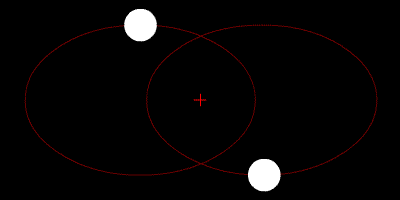Astrophysics[edit]
Binaries provide the best method for astronomers to determine the mass of a distant star. The gravitational pull between them causes them to orbit around their common center of mass. From the orbital pattern of a visual binary, or the time variation of the spectrum of a spectroscopic binary, the mass of its stars can be determined, for example with the binary mass function. In this way, the relation between a star's appearance (temperature and radius) and its mass can be found, which allows for the determination of the mass of non-binaries.
Because a large proportion of stars exist in binary systems, binaries are particularly important to our understanding of the processes by which stars form. In particular, the period and masses of the binary tell us about the amount of angular momentum in the system. Because this is a conserved quantity in physics, binaries give us important clues about the conditions under which the stars were formed.
Calculating the center of mass in binary stars[edit]
In a simple binary case, r1, the distance from the center of the first star to the center of mass or barycenter, is given by:
where:
- a is the distance between the two stellar centers and
- m1 and m2 are the masses of the two stars.
If a is taken to be the semi-major axis of the orbit of one body around the other, then r1 will be the semimajor axis of the first body's orbit around the center of mass or barycenter, and r2 = a – r1 will be the semimajor axis of the second body's orbit. When the center of mass is located within the more massive body, that body will appear to wobble rather than following a discernible orbit.
Center of mass animations[edit]
Images are representative, not simulated. The position of the red cross indicates the center of mass of the system.
 (a.) Two bodies of similar mass orbiting around a common center of mass, or barycenter. |  (b.) Two bodies with a difference in mass orbiting around a common barycenter, like the Charon-Pluto system |  (c.) Two bodies with a major difference in mass orbiting around a common barycenter (similar to the Earth–Moon system) |  (d.) Two bodies with an extreme difference in mass orbiting around a common barycenter (similar to the Sun–Earth system) |
 (e.) Two bodies with similar mass orbiting in an ellipse around a common barycenter. | |||
Research findings[edit]
| Mass Range | Multiplicity Frequency |
|---|---|
| ≤ 0.1 M☉ | 22%+6% −4% |
| 0.1–0.5 M☉ | 26%±3% |
| 0.7±1.3 M☉ | 44%±2% |
| 1.5±5 M☉ | ≥ 50% |
| 8±16 M☉ | ≥ 60% |
| ≥ 16 M☉ | ≥ 80% |
It is estimated that approximately one third of the star systems in the Milky Way are binary or multiple, with the remaining two thirds being single stars.[69] The overall multiplicity frequency of ordinary stars is a monotonically increasing function of stellar mass. That is, the likelihood of being in a binary or a multi-star system steadily increases as the mass of the components increase.[68]
There is a direct correlation between the period of revolution of a binary star and the eccentricity of its orbit, with systems of short period having smaller eccentricity. Binary stars may be found with any conceivable separation, from pairs orbiting so closely that they are practically in contact with each other, to pairs so distantly separated that their connection is indicated only by their common proper motionthrough space. Among gravitationally bound binary star systems, there exists a so-called log normal distribution of periods, with the majority of these systems orbiting with a period of about 100 years. This is supporting evidence for the theory that binary systems are formed during star formation.[70]
In pairs where the two stars are of equal brightness, they are also of the same spectral type. In systems where the brightnesses are different, the fainter star is bluer if the brighter star is a giant star, and redder if the brighter star belongs to the main sequence.[71]
The mass of a star can be directly determined only from its gravitational attraction. Apart from the Sun and stars which act as gravitational lenses, this can be done only in binary and multiple star systems, making the binary stars an important class of stars. In the case of a visual binary star, after the orbit and the stellar parallax of the system has been determined, the combined mass of the two stars may be obtained by a direct application of the Keplerian harmonic law.[72]
Unfortunately, it is impossible to obtain the complete orbit of a spectroscopic binary unless it is also a visual or an eclipsing binary, so from these objects only a determination of the joint product of mass and the sine of the angle of inclination relative to the line of sight is possible. In the case of eclipsing binaries which are also spectroscopic binaries, it is possible to find a complete solution for the specifications (mass, density, size, luminosity, and approximate shape) of both members of the system.
Planets[edit]
While a number of binary star systems have been found to harbor extrasolar planets, such systems are comparatively rare compared to single star systems. Observations by the Kepler space telescope have shown that most single stars of the same type as the Sun have plenty of planets, but only one-third of binary stars do. According to theoretical simulations,[73] even widely separated binary stars often disrupt the discs of rocky grains from which protoplanets form. On the other hand, other simulations suggest that the presence of a binary companion can actually improve the rate of planet formation within stable orbital zones by "stirring up" the protoplanetary disk, increasing the accretion rate of the protoplanets within.[74]
Detecting planets in multiple star systems introduces additional technical difficulties, which may be why they are only rarely found.[75]Examples include the white dwarf-pulsar binary PSR B1620-26, the subgiant-red dwarf binary Gamma Cephei, and the white dwarf-red dwarfbinary NN Serpentis; among others.[76]
A study of fourteen previously known planetary systems found three of these systems to be binary systems. All planets were found to be in S-type orbits around the primary star. In these three cases the secondary star was much dimmer than the primary and so was not previously detected. This discovery resulted in a recalculation of parameters for both the planet and the primary star.[77]
Science fiction has often featured planets of binary or ternary stars as a setting, for example George Lucas' Tatooine from Star Wars, and one notable story, "Nightfall", even takes this to a six-star system. In reality, some orbital ranges are impossible for dynamical reasons (the planet would be expelled from its orbit relatively quickly, being either ejected from the system altogether or transferred to a more inner or outer orbital range), whilst other orbits present serious challenges for eventual biospheres because of likely extreme variations in surface temperature during different parts of the orbit. Planets that orbit just one star in a binary system are said to have "S-type" orbits, whereas those that orbit around both stars have "P-type" or "circumbinary" orbits. It is estimated that 50–60% of binary systems are capable of supporting habitable terrestrial planets within stable orbital ranges.[74]
Examples[edit]
The large distance between the components, as well as their difference in color, make Albireo one of the easiest observable visual binaries. The brightest member, which is the third-brightest star in the constellation Cygnus, is actually a close binary itself. Also in the Cygnus constellation is Cygnus X-1, an X-ray source considered to be a black hole. It is a high-mass X-ray binary, with the optical counterpart being a variable star.[78]Sirius is another binary and the brightest star in the night time sky, with a visual apparent magnitude of −1.46. It is located in the constellation Canis Major. In 1844 Friedrich Bessel deduced that Sirius was a binary. In 1862 Alvan Graham Clark discovered the companion (Sirius B; the visible star is Sirius A). In 1915 astronomers at the Mount Wilson Observatory determined that Sirius B was a white dwarf, the first to be discovered. In 2005, using the Hubble Space Telescope, astronomers determined Sirius B to be 12,000 km (7,456 mi) in diameter, with a mass that is 98% of the Sun.[79]
An example of an eclipsing binary is Epsilon Aurigae in the constellation Auriga. The visible component belongs to the spectral class F0, the other (eclipsing) component is not visible. The last such eclipse occurred from 2009–2011, and it is hoped that the extensive observations that will likely be carried out may yield further insights into the nature of this system. Another eclipsing binary is Beta Lyrae, which is a semidetached binary star system in the constellation of Lyra.
Other interesting binaries include 61 Cygni (a binary in the constellation Cygnus, composed of two K class (orange) main-sequence stars, 61 Cygni A and 61 Cygni B, which is known for its large proper motion), Procyon (the brightest star in the constellation Canis Minor and the eighth-brightest star in the night time sky, which is a binary consisting of the main star with a faint white dwarf companion), SS Lacertae (an eclipsing binary which stopped eclipsing), V907 Sco (an eclipsing binary which stopped, restarted, then stopped again) and BG Geminorum(an eclipsing binary which is thought to contain a black hole with a K0 star in orbit around it), 2MASS J18082002-5104378 (a binary in the "thin disk" of the Milky Way, and containing one of the oldest known stars).[80]





No comments:
Post a Comment